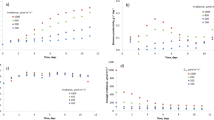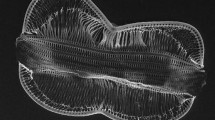Abstract
Growth and eicosapentaenoic acid (EPA) productivity of the diatomPhaeodactylum tricornutum grown semicontinuously in a helical tubular photobioreactor were examined under a range of irradiances (approximately 56 to 1712 µmol photons m-2 s-1) and cell densities (≈3 × 106 to 18 × 106 cells mL-1). Self shading sets the upper limit of operational maximum cell density. Higher irradiance increases this upper limit and also increase the growth rate. Biomass productivity and EPA productivity were enhanced at those cell densities which support the fastest growth rate irrespective of irradiance. The cell protein content increased with increasing irradiance and the carbohydrate and lipid content increased with increasing cell density. EPA productivity was greatest at the highest irradiance. This study shows that biomass productivity and EPA productivity can be maximised by optimising cell density and irradiance, as well as by addition of CO2.
Similar content being viewed by others
References
Alonso L, Grima EM, Perez JAS, Sanchez JLG, Camacho FG (1992) Fatty acid variation among different isolates of a single strain ofIsochrysis galbana. Phytochem. 31: 3901–3904.
Becker EW (1984) Biotechnology and exploitation of the green algaScenedesmus obliquus in India. Biomass 4: 1–19.
Bligh EG, Dyer WJ (1959) A rapid method of total lipid extraction and purification. Can. J. Biochem. Physiol. 37: 911–917.
Bocci F, Torzillo G, Vincenzini M, Materassi R (1988) Growth physiology ofSpirulina platensis in tubular photobioreactor under natural light. In Stadler T, Mollion J, Verdus MC, Karamanos Y, Morvan H, Christiaen D (eds), Algal Biotechnology. Elsevier Applied Science, London: 219–228.
Borowitzka MA (1988) Microalgae as sources of essential fatty acids. Aust. J. Biotechnol. 1: 58–62.
Borowitzka MA, Volcani BE (1978) The polymorphic diatomPhaeodactylum tricornutum: Ultrastructure of its morphotypes. J. Phycol. 14: 10–21.
Chrismadha T, Borowitzka MA (1993) Growth and lipid production ofPhaeodactylum tricornutum in a tubular photobioreactor. In Moi PS, Lee YK, Borowitzka MA, Whitton BA (eds), Algal Biotechnology in the Asia-Pacific Region. Institute of Advanced Studies, University of Malaya, Kuala Lumpur, (in press).
Christie WW (1989) Gas Chromatography and Lipids. The Oily Press, Ayr, Scotland, 307 pp.
Claustre H, Gostan J (1987) Adaptation of biochemical composition and cell size to irradiance in two microalgae: possible ecological implications. Mar. Ecol. Progr. Ser. 40: 167–174.
Dauta A, Devaux J, Piquemal F, Boumnich L (1990) Growth rate of four freshwater algae in relation to light and temperature. Hydrobiologia 207 (Dev. Hydrobiol. 62): 221–226.
Dunstan GA, Volkman JK, Barrett SM, Garland CD (1993) Changes in the lipid composition and maximisation of the polyunsaturated fatty acid content of 3 microalgae grown in mass culture. J. appl. Phycol. 5: 71–83.
Fabregas J, Herrero C, Cabezas BV, Abalde J (1987) Growth and biochemical variability of the marine microalgaChlorella stigmatophora in batch cultures with different salinities and nutrient gradient concentration. Br. Phycol. J. 22: 269–276.
Fawley MW (1984) Effects of light intensity and temperature interaction on growth characteristics ofPhaeodactylum tricornutum (Bacillariophyceae). J. Phycol. 20: 67–72.
Goldman JC, Dennett MR, Riley CB (1981) Inorganic carbon sources and biomass regulation in intensive microalgal cultures. Biotechnol. Bioengng 23: 995–1014.
Guillard RRL, Ryther JH (1962) Studies on marine planktonic diatoms. I.Cyclotella nana Hustedt andDetonula confervacea (Cleve) Gran. Can. J. Microbiol. 8: 229–239.
Harrison PJ, Thompson PA, Calderwood GS (1990) Effects of nutrient and light limitation on the biochemical composition of phytoplankton. J. appl. Phycol. 2: 45–56.
Holdsworth ES, Golbeck J (1976) The pattern of carbon fixation in the marine unicellular algaPhaeodactylum tricornutum. Mar. Biol. 38: 189–199.
Javanmardian M, Palsson BO (1991) High-density photoautotrophic algal cultures — design, construction, and operation of a novel photobioreactor system. Biotechnol. Bioengng 38: 1182–1189.
Kates M, Volcani BE (1966) Lipid components of diatoms. Biochim. Biophys. Acta 116: 264–278.
Kochert G (1978) Carbohydrate determination by the phenol-sulphuric acid method. In Hellebust JA, Craigie JS (eds), Handbook of Phycological Methods. Physiological and Biochemical Methods. Cambridge University Press, Cambridge: 95–97.
Lowrey OH, Rosenbrough NJ, Farr AL, Randall RJ (1951) Protein measurement with the folin phenol reagent. J. biol. Chem. 1983: 265–275.
Parrish CC, Wangersky PJ (1990) Growth and lipid class composition of the marine diatom,Chaetoceros gracilis, in laboratory and mass culture on turbidostats. J. Plankton Res. 12: 1011–1021.
Rabe AE, Benoit J (1962) Mean light intensity — a useful concept in corellating growth rates of dense cultures of microalgae. Biotechnol. Bioengng 4: 377–390.
Renaud SM, Parry DL, Thinh LV, Kuo C, Padovan A, Sammy N (1991) Effect of light intensity on the proximate biochemical and fatty acid composition ofIsochrysis sp. andNannochloropsis oculata for use in tropical aquaculture. J. appl. Phycol. 3: 43–53.
Richmond A (1992) Open systems for the mass production of photoautotrophic microalgae outdoors — Physiological principles. J. appl. Phycol. 4: 281–286.
Richmond A, Boussiba S, Vonshak A, Kopel R (1993) A new tubular reactor for mass production of microalgae outdoors. J. appl. Phycol. 5: 327–332.
Robinson LF, Morrison AW, Bamforth MR (1988) Improvements relating to biosynthesis. European Patent Number 261, 872.
Spectorova LV, Goronkova OI, Nosova LP, Albitskyaya ON (1981) High density culture of marine microalgae — Promising items for mariculture. I. Mineral feeding regime and installations for culturingDunaliella tertiolecta Butch. Aquacult. 26: 289–302.
Spectorova LV, Nosova LP, Goronkova OI, Aibitskaya ON, Filippovskij YN (1986) High-density culture of marine microalgae — promising items for mariculture II. Determination of optimal light regime forChlorella sp.f. marina under high-density culture conditions. Aquacult. 55: 221–229.
Sukenik A (1991) Ecophysiological considerations in the optimization of eicosapentaenoic acid production byNannochloropsis sp. (Eustigmatophyceae). Bioresource Technol. 35: 263–269.
Sukenik A, Carmeli Y, Berner T (1989) Regulation of fatty acid composition by irradiance level in the EustigmatophyteNannochloropsis sp. J. Phycol. 25: 686–692.
Tedesco MA, Duerr EO (1989) Light, temperature and nitrogen starvation effects on the total lipid and fatty acid content and composition ofSpirulina platensis UTEX1928. J. appl. Phycol. 1: 201–209.
Terry KL, Hirata J, Laws EA (1983) Light-limited growth of two strains of the marine diatomPhaeodactylum tricornutum Bohlin: Chemical composition, carbon partitioning and the diel periodicity of physiological processes. J. exp. mar. Biol. Ecol. 68: 209–227.
Thompson PA, Harrison PJ, Whyte JNC (1990) Influence of irradiance on the fatty acid composition of phytoplankton. J. Phycol. 26: 278–288.
Tredici MR, Materassi R (1992) From open ponds to vertical alveolar panels — The Italian experience in the development of reactors for the mass cultivation of phototrophic microorganisms. J. appl. Phycol. 4: 221–231.
Tsuzuki M, Ohnuma E, Sato N, Takaku T, Kawaguchi A (1990) Effects of CO2 concentration during growth on fatty acid composition in microalgae. Plant Physiol. 93: 851–856.
Veloso V, Reis A, Gouveia L, Fernandes HL, Empis JA, Novais JM (1991) Lipid production byPhaeodactylum tricornutum. Bioresource Technol. 38: 115–119.
Vonshak A, Richmond A (1985) Problems in developing the biotechnology of algal mass production. Plant & Soil 89: 129–135.
Weissman JC, Goebel RP (1987) Design and analysis of microalgal open pond systems for the purpose of producing fuels. Solar Energy Research Institute, Report SERI/STR-231-2840: 1–214.
Yongmanitchai W, Ward OP (1991a) Growth of and omega-3 fatty acid production byPhaeodactylum tricornutum under different culture conditions. Appl. envir. Microbiol. 57: 419–425.
Yongmanitchai W, Ward OP (1991b) Screening of algae for potential alternative sources of eicosapentaenoic acid. Phytochem. 30: 2963–2967.
Author information
Authors and Affiliations
Additional information
Author for correspondence
Rights and permissions
About this article
Cite this article
Chrismadha, T., Borowitzka, M.A. Effect of cell density and irradiance on growth, proximate composition and eicosapentaenoic acid production ofPhaeodactylum tricornutum grown in a tubular photobioreactor. J Appl Phycol 6, 67–74 (1994). https://doi.org/10.1007/BF02185906
Received:
Accepted:
Issue Date:
DOI: https://doi.org/10.1007/BF02185906




